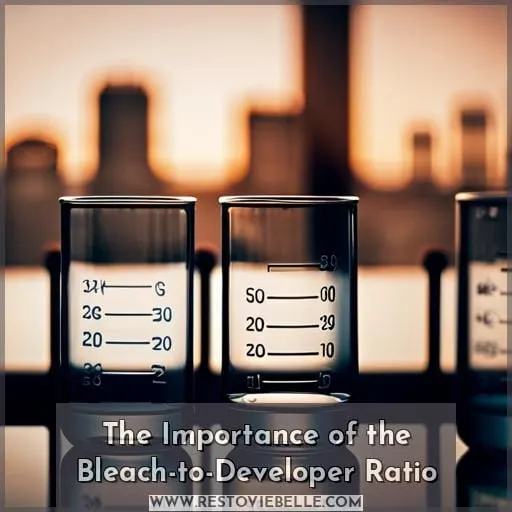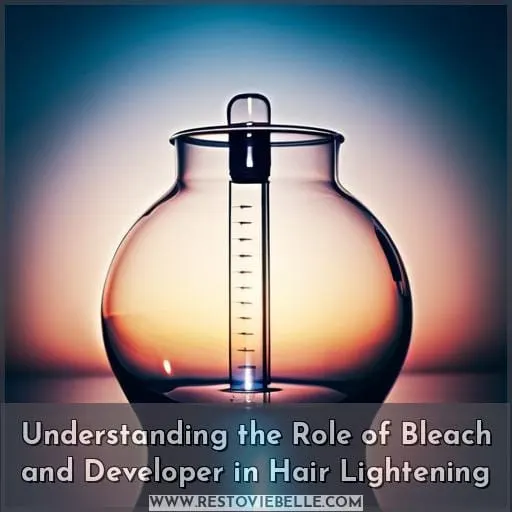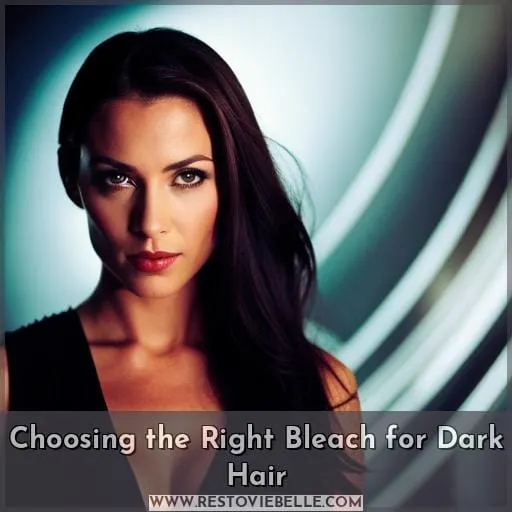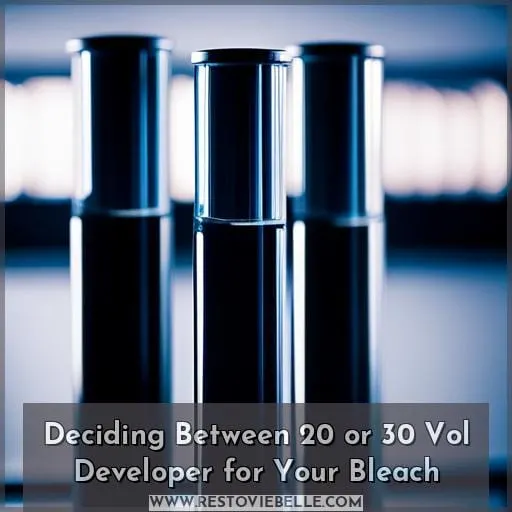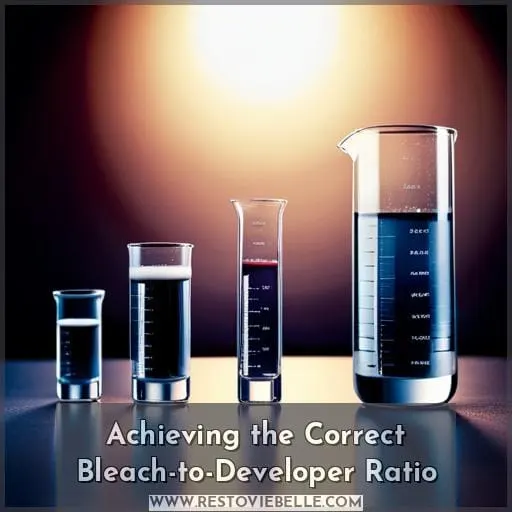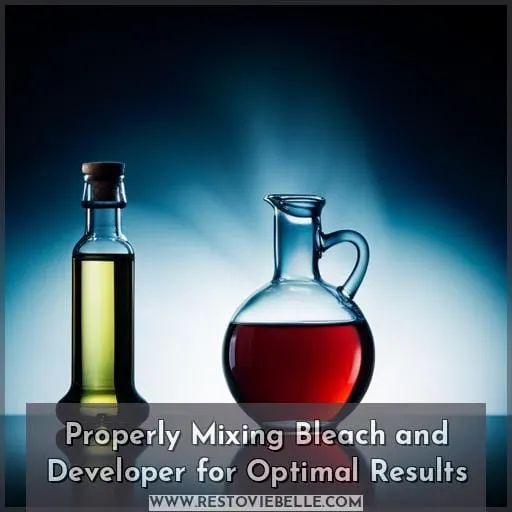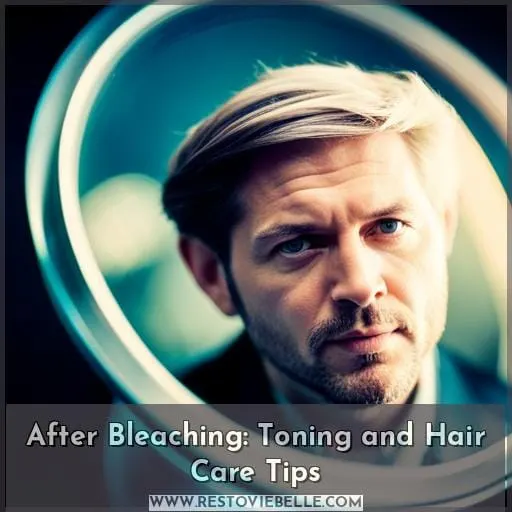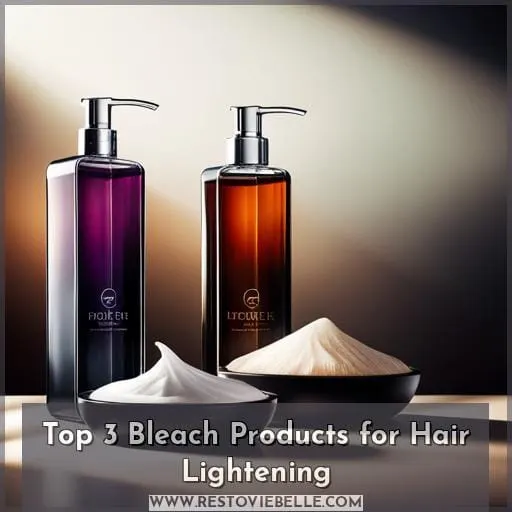This site is supported by our readers. We may earn a commission, at no cost to you, if you purchase through links.

The first step in achieving salon level quality is understanding what role each product plays when bleaching. Developer helps lift out existing pigment from the hair while bleach acts as an oxidizer, lifting dark pigments out with peroxide molecules and allowing new colors or shades into the strands themselves.
Different ratios are needed depending on how dark or long your hair is, so make sure you know exactly what type of bleach and developer combination works best for you before starting any chemical processes!
Table Of Contents
- Key Takeaways
- The Importance of the Bleach-to-Developer Ratio
- Understanding the Role of Bleach and Developer in Hair Lightening
- The Best Bleach for On-Scalp Applications
- Choosing the Right Bleach for Dark Hair
- Deciding Between 20 or 30 Vol Developer for Your Bleach
- Can You Bleach Hair That Has Already Been Colored?
- Achieving the Correct Bleach-to-Developer Ratio
- Properly Mixing Bleach and Developer for Optimal Results
- Applying the Bleach Mixture to Your Hair
- After Bleaching: Toning and Hair Care Tips
- Top 3 Bleach Products for Hair Lightening
- Conclusion
Key Takeaways
- Start with a 1:2 bleach-to-developer ratio.
- Adjust ratios depending on the strength of the product.
- Avoid over-dilution with excessive developer.
- The bleach-to-developer ratio is crucial for achieving desired results.
The Importance of the Bleach-to-Developer Ratio
Getting the right mix of products for bleaching at home is essential to achieving vibrant, long-lasting results – so don’t forget about getting that perfect ratio!
The bleach-to-developer ratio has a significant influence on hair color lift and damage prevention. To achieve consistency, start with the standard 1:2 ratio (one part bleach powder to two parts developer).
For quicker lightening, increase the amount of powder; for slower lightening, use a lower proportion.
However, it’s important to adjust your ratios based on product strength. Stronger bleaches require lower ratios, while weaker ones need higher amounts. When mixing at home, be sure not to over dilute your mixture by using too much developer.
This can lead to undesirable tones and risks such as dryness or breakage due to excessive processing time.
With careful attention and precision, you can create beautiful blonde hair without worrying about damaging it in any way! Follow these tips combined with quality products containing keratin or amino acids.
This will help ensure healthier-looking locks after bleaching, along with regular trims every 6–8 weeks, plus purple shampoo toning for the best results.
Understanding the Role of Bleach and Developer in Hair Lightening
Understanding the role of bleach and developer in hair lightening is essential for achieving vibrant, long-lasting color – so get ready to mix up your own concoction!
Developer opens the cuticle layer of the hair shaft to allow for maximum pigment removal. When mixed correctly, a balanced blend yields an easy application without patchiness or clumping. That’s why it’s important to use the right bleach-to-developer ratio. Usually, it’s 1 part powder to 2 parts liquid or cream developer, though this can vary depending on product strength and desired lift level.
Consider 20 Vol when lifting up 3 levels at roots and 30 Vol if going further at lengths.
To ensure success with lighter shades, achieve gradual lightening by applying low volumes first, then move onto higher ones once the desired level is reached before toning afterwards with purple shampoos for white results.
The Best Bleach for On-Scalp Applications
When looking for the best bleach for on-scalp applications, there are a few important points to consider. First off, it’s essential to choose a product that is compatible with your chosen developer volume.
Different bleaching techniques may require different ratios of bleach and developer, so be sure you understand how much of each ingredient should be used in order to get the desired outcome.
It’s also important to take into account whether or not you have sensitive skin on your scalp before applying any harsh products.
Finally, it pays dividends knowing exactly how much time must pass between mixing and using the mixture in order for optimal results.
Choosing the Right Bleach for Dark Hair
For dark hair, choose a stronger bleach like Brilliant Blondexx for up to 8 levels of lift and the protection of Bond Protect. Preparation techniques are important when bleaching dark hair; selecting the right developer can make or break your results.
Here’s what you need to know:
- Preparing your area is key. Use non-metal bowls for mixing, gloves, and protective eyewear during application, and tools such as combs and clips.
- Choose a blue powder bleach with 20 Vol developers for roots. Switch to 30 Vol if more lift is needed on lengths or over color build-up areas throughout the head.
- Once applied, wait no longer than 40 minutes before rinsing with specialized shampoo & conditioner, then toning with Ugly Duckling purple products.
Finally, follow post-bleach maintenance advice, including deep conditioning treatments and regular trims every 6 – 8 weeks! With these tips, you’ll be able to achieve perfect blonde that works best according to your individual needs.
Deciding Between 20 or 30 Vol Developer for Your Bleach
Deciding between the different developer volumes for your bleach can be a challenge, but it’s worth getting right to achieve perfect color results! The ratio of bleach to developer is key, and selecting either 20 Vol or 30 Vol can make all the difference.
For root application, use 20 Vol as this stays 1/8 inch away from the scalp. For full head bleaching, start at the back with 30 Vol before switching to 20 Vol on roots. Dark hair should begin with 30 Vol then switch over for more lift in areas near the root area using a fine-toothed comb sectioning technique.
If there is an issue of build-up, such as colored hair needing stronger developers due to pigmentation density, opt for a Bleach Wash instead. Mix equal parts bleach powder and shampoo together along with water and developer (20 Vol).
Before starting any process, always conduct sensitivity tests first if clients have sensitive skin.
With careful attention paid towards product selection plus proper technique, success will come easier than ever before when aiming for that perfect shade!
Can You Bleach Hair That Has Already Been Colored?
If you want to bleach hair that’s already been colored, it’s important to understand the risks and use a stronger developer than usual. Color correction can be tricky. Bleaching will strip away existing color molecules, and fading colors may not give the desired result.
If your hair was recently tinted for a root touch-up, wait at least two weeks before attempting any lightening process with bleach. This could cause damage or unexpected results due to interference of product chemistry.
When dyeing pre-colored hair, use higher volumes of developers, such as 30 Vol instead of 20 Vol, for more effective lifting action on layers dyed in darker shades. These shades are harder to lighten up quickly without causing breakage or damaging areas near roots or scalp where sensitivity matters most during application processes like bleaching.
To ensure safe outcomes while maintaining healthy strands through proper maintenance routine after bleaching, always follow directions regarding the ratio mix between bleach powder and developer when going lighter with already colored tresses using color correction techniques.
Achieving the Correct Bleach-to-Developer Ratio
To achieve optimal results for your hair lightening project, it’s essential to get the right balance between bleach and developer.
Start with a common 1:1 ratio of bleach to developer, but adjust it according to the strength of the product.
Mixing techniques are also key. A thicker mixture yields painting techniques or streaks at 1:1 ratios, while creamy mixtures use a 1:2 ratio.
Colorists recommend using 20 Vol peroxide for up to 3 levels of lift at the roots, and then switching to 30 Vol on the lengths. For dark hair, it’s best to start with 30 Vol and then use 20 Vol near the scalp area.
Before applying the bleach, always conduct sensitivity tests beforehand. Apply the bleach to dry, unwashed hair and section it carefully when applying near the roots.
Avoid incremental bleaching, as it weakens the strands further and may cause brittleness if overdone. It’s important to use quality products like Bond Protect technology, which helps keep the cuticles open longer during the processing time without causing damage.
Properly Mixing Bleach and Developer for Optimal Results
Mixing bleach and developer correctly ensures the best results for vibrant hair colors. Avoid common mistakes such as using too much powder or the wrong ratio, which can lead to patchiness or over-bleaching.
Measuring accuracy is essential. Use a 1:1 ratio at minimum, but adjust the amount depending on the product strength and desired color level. For dark hair, it may be necessary to increase the volume of developer used to achieve optimal lightening.
Consider using 30 Vol for up to three levels of lift, then switch back down to 20 Vol when near root application begins.
Selecting an appropriate developer is also key. Liquid formulas are better suited for precise applications, while creams offer more conditioning properties. They contain added ingredients like moisturizers and oils that help reduce scalp irritation during the coloring process.
Following these steps will ensure a successful bleaching experience with minimal damage.
Applying the Bleach Mixture to Your Hair
Ready your tools and take a deep breath – it’s time to bring those beautiful highlights alive with the perfect bleach mixture.
Start by doing a quick strand test with the ratio of bleach to developer you’re using. Then, section off cleanly parted hair as desired for application techniques like painting or streaks.
When you’re ready, mix the products according to the directions and start applying evenly on dry hair from mid-shaft down. Continue until you reach the desired lightness level of 9 or 10 blonde results without any patchiness.
Don’t forget that near root application requires 20 Vol developer, kept 1/8 inch away from the scalp. For full head bleaching, start at the back and do the roots last for toning later on.
With the correct ratio of bleach to developer and attention during the developing process, achieving optimal results is well within reach!
After Bleaching: Toning and Hair Care Tips
Now that you’ve applied the bleach mixture to your hair, it’s time to think about toning and post-bleaching care.
Toning techniques are key in achieving a beautiful blonde shade. Using a purple shampoo can help neutralize and cool down brassiness in lightened hair while also maintaining color vibrancy long term.
Additionally, moisturizing products will be necessary for restoring moisture lost from bleaching as well as protecting against breakage when styling or using heat tools on your newly lightened locks.
For those with colored hair who experience a build-up of colorant after bleaching, special methods can be used to correct this issue. One method is doing a bleach wash with equal parts bleach powder, 20 volume developer, shampoo, and water.
This can be followed by using Ugly Duckling toners, which provide white results instead of yellowish tones often caused by improper ratios of darkening agents during previous coloring services.
When selecting toning products, always look for natural ingredients like keratin proteins, which help maintain healthy-looking strands, and amino acids that promote manageability.
For darker shades, try their Purple Shampoo & Mask along with Anti-Breakage Products formulated specifically to protect against split ends due to their restructuring abilities.
Follow these tips if you want healthier, lusciously bleached tresses!
Top 3 Bleach Products for Hair Lightening
If you’re looking to achieve vibrant hair color, bleaching is a great option. L’Oréal Paris Quick Blue Bleach for up to 7 levels of lift, Wella Colorcharm Developer 20V for lasting results, and Superstar Super Star 20v Creme Developer 32oz with its gel consistency are just some of the top three bleach products available.
1. Loreal Paris Quick Blue Bleach
When lightening your hair, Loreal Paris Quick Blue Bleach is an excellent choice for achieving quick and effective results. Just ask Jessie, who used it to lift her dark hair seven levels in one go! The dust-free formula prevents drips and mess while providing superior brightness.
It’s important to use protective measures when bleaching at home, such as gloves and a patch test prior to full application.
For best results, stick with the recommended 1:2 bleach-to-developer ratio. Use blue-based bleach on darker locks or white powder on lighter shades. By following the instructions carefully, you can achieve beautiful blonde without breakage.
2. Wella Colorcharm Developer 20V
With Wella Colorcharm Developer 20V, you’ll find a professional-grade hair color developer designed for use with liquid, gel, and lightener products. It contains water, hydrogen peroxide, and other ingredients to create long-lasting color results.
This product is compatible with mixing techniques such as painting or streak application and offers different strengths of bleach depending on the desired results.
3. Superstar Super Star 20v Creme Developer 32oz
Supercharge your hair lightening with Superstar Super Star 20v Creme Developer 32oz, a stabilized cream peroxide developer that maintains strength longer than liquid peroxides. With its gel consistency and American origin, you can trust it to deliver professional-level results for long-lasting color.
The 20 volume allows for maximum lift without compromising the integrity of the strands while giving off an unmistakable shine! Keep in mind that this creme developer is more concentrated than liquid ones, so be sure to double-check the ratio of bleach to developer when using it.
Conclusion
Achieving the perfect bleach-to-developer ratio for stunning hair lightening results requires careful consideration. Bleach and developer both play an important role in the process, and the ratio will vary depending on the type of hair and desired outcome.
For on-scalp applications, Loreal Paris Quick Blue Bleach is a great choice, while Wella Colorcharm Developer 20V is ideal for salon professionals. Superstar Super Star 20v Creme Developer 32oz is also a great choice for long-term color applications.
Depending on the darkness of the hair, 20 or 30 Vol developer can be used. Bleaching colored hair may require a stronger developer due to color build-up.
It’s important to start with a 1:1 bleach-to-developer ratio and adjust as needed. Properly mixing and applying the bleach mixture is key for successful results, as is toning and providing post-bleaching care and maintenance.

